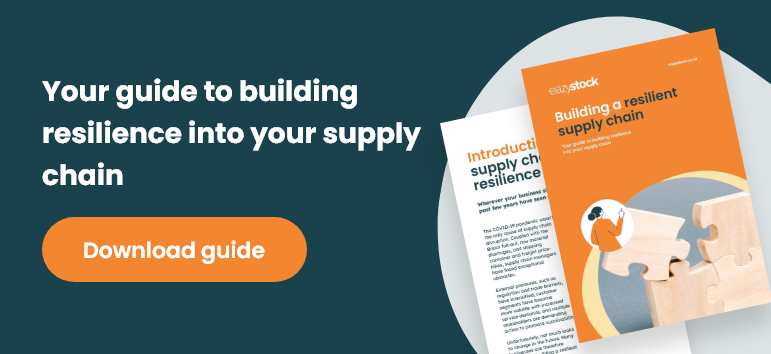How to develop an effective supply chain strategy
What is a supply chain strategy?
A supply chain strategy explains how a company will bring goods into the business and get them out to customers as effectively as possible. Considering every phase in the supply chain, such as sourcing goods, logistics and delivery, the strategy optimizes operations to reduce costs and maximize profits.
Supply chain strategies have come into the spotlight as volatile demand and complicated global markets have made supply chains more complex. It’s become vital for companies to have robust supply chain processes to overcome any supply chain disruption.
Unfortunately, off-the-shelf supply chain strategies don’t exist. You need to tailor your strategy to your company, industry, and business goals. This article will discuss some areas that you should review to develop your strategy.
Why do you need a supply chain strategy?
A good supply chain strategy is about fulfilling demand, driving customer value, improving responsiveness, facilitating financial success and building a good network. The primary goals of efficient supply chain management should be faster delivery, higher efficiency and accelerated cash flow.
A robust supply chain management strategy can also reduce risk and lower the impact of disruption in the supply chain. Processes and systems to help respond to issues will aid with faster recovery and enable you to build or maintain your competitive advantage.
What is the focus of your supply chain strategy?
There are two ways to develop your supply chain strategy.
- Supply chains oriented to efficiency. These suit industries where products are either low cost or high revenue – or both. These include cement, steel, paper, commodities and low-cost fashion.
- Supply chains oriented to responsiveness. These work best where there is high demand uncertainty and customer or market needs can change quickly.

Creating a supply chain strategy
There are three phases to creating a supply chain strategy:
- Supply chain strategy design – at this stage, you will decide the company’s strategic objectives and KPIs. You should also review and choose suppliers, decide where to locate warehouses and whether to implement software throughout the supply chain.
- Supply chain strategy planning – if you understand your strategic objectives, you will be able to plan how to balance supply and demand. This will ensure that you have the right goods, at the right time, and in the right place to meet customer demand.
- Supply chain strategy execution – this is where inventory teams will manage warehouses and inventory levels to ensure the company can meet customer demand.
Supply chain strategy design
Optimizing your supply chain design starts with understanding your current supply chain. Where is it working well? Where is it causing you problems?
Each part of the supply chain is connected, meaning a problem in one area can compromise the entire global network.

If possible, use real-time data and big data insights to delve deep into each area of your supply chain. This will provide maximum analysis and understanding of your current setup and support sales and operations planning.
Highlighting areas for improvement allows you to fix them. For example, having more accurate demand forecasting, warehouse automation, diversifying your supplier network or bringing new technologies on board to give you real-time data.
Your strategies should have backup plans, with backup plans for your backup plans!
Supply chain strategy planning
Four components of supply chain planning:
- Integration and departmental communication
A single view of accurate and reliable information across your business is critical for coordination, measurement, and control. It ensures everyone in the company is looking at the same information and understands the supply situation. A fully integrated system that tracks real-time information means you can plan for and mitigate supply disruptions. - Day-to-day operations management
Once again, you need real-time, good data to control supply. Understanding demand and having plans to respond to demand fluctuations allows you to streamline your processes. Efficient operational processes can reduce costs and facilitate smoother fulfillment. Keeping inventory levels lean with buffer or safety stock minimizes the impact of supply chain disruption. - Purchasing
Accurate demand forecasting is vital to ensure replenishment meets demand and you avoid over or understocking. Demand forecasting software provides more reliable information than spreadsheets to ensure you have the right product, in the right quantity, at the right time. The software can automate your reordering, monitor supplier costs and lead times and alert you to any changes that affect your operating costs. - Distribution and logistics
There are many challenges facing companies when it comes to distribution and logistics. Not only are they looking to reduce costs, but they also need to consider sustainability, people, processes and alternative methods in case of disruption. Systems also need to coordinate customer orders with delivery schedules, invoices, and dispatch. If distribution to customers isn’t reliable or efficient, there’s a risk of dissatisfied customers taking their business elsewhere.
Supply chain strategy execution
Supply chain management (SCM) is how you execute your supply chain strategy. It involves coordinating suppliers, logistics, warehouses and orders across the global supply chain to ensure you can meet customer demand.
 Effective supply chain management can prevent damage to a company’s reputation and ensure it can meet business objectives and sustain a competitive advantage. To maintain or improve effectiveness, you must continually review your supply chain management execution to highlight any inefficiencies or gaps. You should keep on top of trends in supply and demand and any seasonal fluctuations.
Effective supply chain management can prevent damage to a company’s reputation and ensure it can meet business objectives and sustain a competitive advantage. To maintain or improve effectiveness, you must continually review your supply chain management execution to highlight any inefficiencies or gaps. You should keep on top of trends in supply and demand and any seasonal fluctuations.
Understanding supply chain trends and new technology will also help you identify areas of improvement in your supply chain strategy and inventory management processes.
Using software to execute your supply chain strategy
An effective supply chain strategy depends on the right technology and software to support its implementation. Appropriate software will help you save time and become more efficient. It can also help mitigate supply chain risks, which can help protect already tight profits.
Examples of supporting software include:
- Warehouse management systems. A modern database can provide real-time insights to increase stock visibility and streamline warehouse processes. It can connect to existing ERPs or business systems to improve warehouse flexibility, responsiveness, safety, security and customer service.
- Picking technologies. Automated picking software and hardware, such as pick to light or voice, highlight the most efficient pick path and speed up the picking processes.
- Inventory optimization. Specialist inventory optimization tools remove the need to calculate inventory needs using spreadsheets or basic tools. They can quickly provide accurate and reliable data to help manage erratic market demand or supply chain volatility, reducing the risk of stockouts.
Depending on company goals, more advanced systems, such as automated guided vehicles, robots, drones, and artificial intelligence, can also support supply chain strategies.
If you’d like to discuss your supply chain strategy and how EazyStock can support inventory management, please speak to one of our team to arrange a demo.








